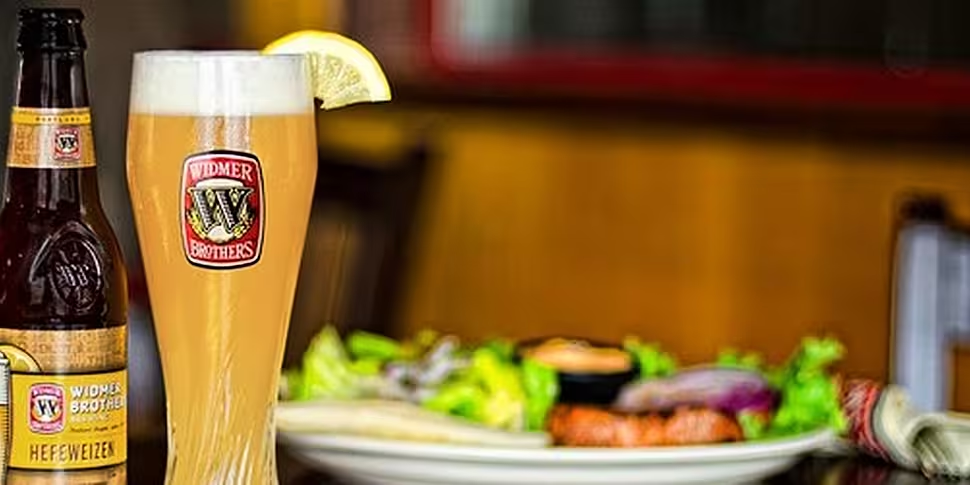Beer has always been a drink to bring people together. Not only that, but brewers around the world look to other countries for inspiration for the beers that they are brewing.
Today, we are looking at two beers that are brewed in the US and Ireland. Both beers are brewed to styles that originated in foreign countries. In both cases, the brewers have put their own signature twist on the beer – and made the style their own. In the case of the first of our beers, this has lead to the emergence of a brand new style – the American Hefeweiss.
Widmer Hefeweiss
Beer Style: American Hefeweiss, alcohol by volume is 4.9% a.b.v., brewed by Widmer Brothers in Portland, Oregon.
This beer has become the signature for a new style of beer developed by the American craft beer movement. In 1984, Kurt and Rob Widmer, in the midst of dual quarter-life crises, followed their heart and their dreams, quit their jobs and started a brewery in Portland, Oregon. Blazing a trail, they started with Widmer Hefeweiss.
Widmer Hefeweiss presents with the classic cloudy rich gold colour that one expects with a hefe-weiss. The head presents with a bright, clean, tight and brilliant white.
While the range of fruit and spice flavour that one would expect with a German hefeweiss can vary across a range, the signature flavours that one would associate with German hefeweiss are clove and ripe yellow banana. Widmer hefeweiss breaks the mould, and, while it is a beer that is distinctly inspired by the classic wheat beer style from Kurt and Rob’s home country of Germany, Widmer hefeweiss has effectively established a new style – the American Hefeweiss.
Aromas that greet from Widmer Hefeweiss include crisp, refreshing citrus fruit – lemon-lime – together with cantaloupe melon. Suggestions of grapefruit come through on the nose as well. This beer delivers a delicious foundation of grain character – crisp white bread-roll bread crust combines with honey digestive biscuit. A perfectly balanced suggestion of spice combines with background West-Coast U.S. pine hop character, combining earthy mineral notes to what is a superbly delicious and refreshingly zingy beer.
Beer styles are constantly evolving. As tastes, brewing practises, use of ingredients and changes driven by experimentation evolve, different flavours develop and emerge in beers. In some cases, these changes cause a style to mature and develop from its foundations. In rare instances, the excellent work done by innovative brewers results in the emergence of what becomes recognised as an entirely new style. Widmer Hefeweiss is one such instance of this – the American hefeweiss style infuses West Coast U.S. hops (traditionally hop character is notable muted in a German Hefeweiss), with the characteristic fruitiness and wheat grain character associated with wheat beer. The clove character that one would expect in a German hefeweiss is replaced with subtle piney, spicey character. Many breweries in American have followed the lead to develop their own interpretations of this new style – and teh average beer drinker is ever the better for it.
Widmer Hefeweiss is truly the original American Hefeweiss, and is an example of beer style history emerging and evolving in our own time.
White Hag Fionnabhair
Beer Style: Irish Wit beer, alcohol by Volume is 5.0% a.b.v., brewed by The White Hag Irish Brewing Company in Sligo, Ireland.
The normal situation for craft breweries is that they interpret a style of beer, rather than invent one (as is the case with Widmer Hefeweiss creating the American Hefeweiss style). White Hag Fionnabhair is an example of this, and while the roots of this brewery in Sligo do not come from Belgium (the origin of the witbier style), the choice of this style reflects an interesting parallel between the emergence of a craft brewing industry in Ireland and the revival of a style in Belgium.
In Ireland, brewing on a small scale had all but died out – competition from the big breweries had systematically reduced choice for the Irish beer drinker. Likewise, in the 1950’s and 1960’s the style of witbier had effectively died out in Belgium.
Pierre Celis – a milkman, who lived in the town of Hoegaarden, and had done part-time work for a brewery that brewed witbier – decided that the witbier style should not die out. He was familiar with the slightly eccentric brewing practices associated with brewing witbier, and elected to act as a one-man pioneer ensuring that this brewing style was not lost to history.
Establishing his own brewery in the town of Hoegaarden, he started brewing witbier and single-handedly revived the style. After selling his brewery to Interbrew (now AB Inbev) when a fire damaged part of his buildings leaving him cash-strapped, he objected to the ‘dumbing down’ of his recipe by the brewing multinational. In response, he established a second brewery – this time in Texas – to brew ‘Celis White’ – what he described as the ‘original Hoegaarden’. Up to his death in 2011, when Pierre Celis would arrive at beer festivals, he was treated as a ‘brewing rock star’ – a man who is credited with ensuring that a style not only was not lost to history, but also retained its integrity in the face of pressures from global brewing giants.
It is perhaps ironically appropriate that a brewery in a country such as Ireland would choose to interpret this style – while reviving and re-establishing the Irish craft brewing industry, one of the tools to achieve this goal is a beer style that itself was revived and re-established in Belgium.
Fionnabhair is brewed by White Hag Brewery in Sligo. Following the classic traditions of the style, curacao (orange peel) is infused into the beer, using a West-Coast U.S. ‘Torpedo’ – a technique more normally associated with dry-hopping beers. Giving the beer an Irish twist, heather is used in conjunction with coriander. The grain bill follows the traditions of the witbier style – wheat, combined with malted barley, and a touch of oats.
This beer is very aromatic – strawberry and orange (sweet mandarin orange combining with more subtle bitter orange peel) combine with an array of spices – white pepper, phenolic clove and coriander. The wheat beer foundations of the beer is unmistakeable – both in the white-gold cloudy appearance combined with distinct white head, and in the bread crust flavour in the beer. The finish of the beer is muted and subdued.
Stockists for the beers featured on today's show:
Widmer Beers
- Callans Dundalk
- Holland's, Bray
- Probus Wines
- Spar Rathoath
- Mitchell & Sons, IFSC, Dublin 1
- Ely's Wine Bar & Restaurants, Dublin 1
- Acheson Off-Licence, Crumlin
- Deveney's Off-Licence, Dundrum
- O'Donovan's Off-Licence Group
- Carry-Out Stores
- Supervalu/Centra Stores
- Bradley's, North Main Street, Cork
- The Abbot Ale House, Cork
- Desmond's Next Door, Father Russell Road, Limerick
- Huttod Off-Licence, Midleton
- Matson's Off-Licence, Cork
- Eldon's, Clonmel
- Next Door at Shannon Knights, Co Clare
- Number 21 Off-Licences
- The Blind Pig, Limerick
- The Couter Restaurants, Dublin
- Pichet Restaurant
- Saba Restaurant
- Dwan's Spar
- Baggot Street Wines
- Next Door, Kimmage
- Donnybrook Fair
- Griffin's Londis, KCR
- Healy's, Wicklow
- The Old Orchard
- The Old Forge, Abbey Street
- Eddie Rockets Restaurants
- The Avenue Restaurant, Dublin
- Topaz Service Stations (with Off-Licences)
White Hag Fionnabhair Witbier
- Finns Bar,
- The Winehouse, Trim.
- Redmond’s of Ranelagh
- Baggot Street Wines
- Hartley’s Restaurant
- Bradley’s of Cork
- No. 21 Off-Licence, Cork
- Whelan’s Off-Licence
- Bunsen, Templebar
- Drink Store, Manor Street
- Spar, Braemor Road
- Blackrock Cellars
- Higgin’s Off-Licence
- McCambridges of Galway
- Jus de Vine, Portmarnock
- Deveney’s, Rathmines
- Cassidy’s Bar
- Supervalu, Celbridge
- Mace, Navan Road.









